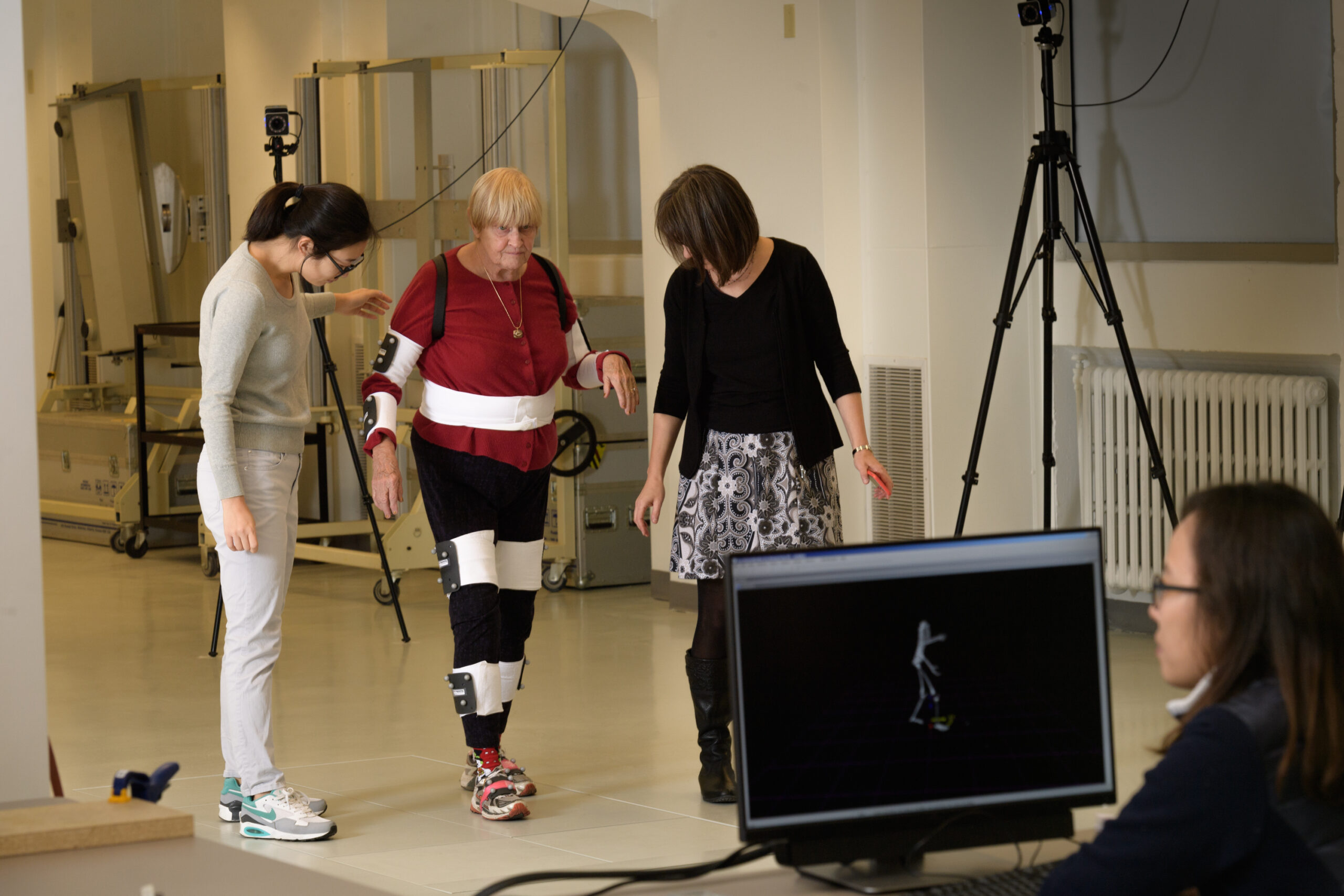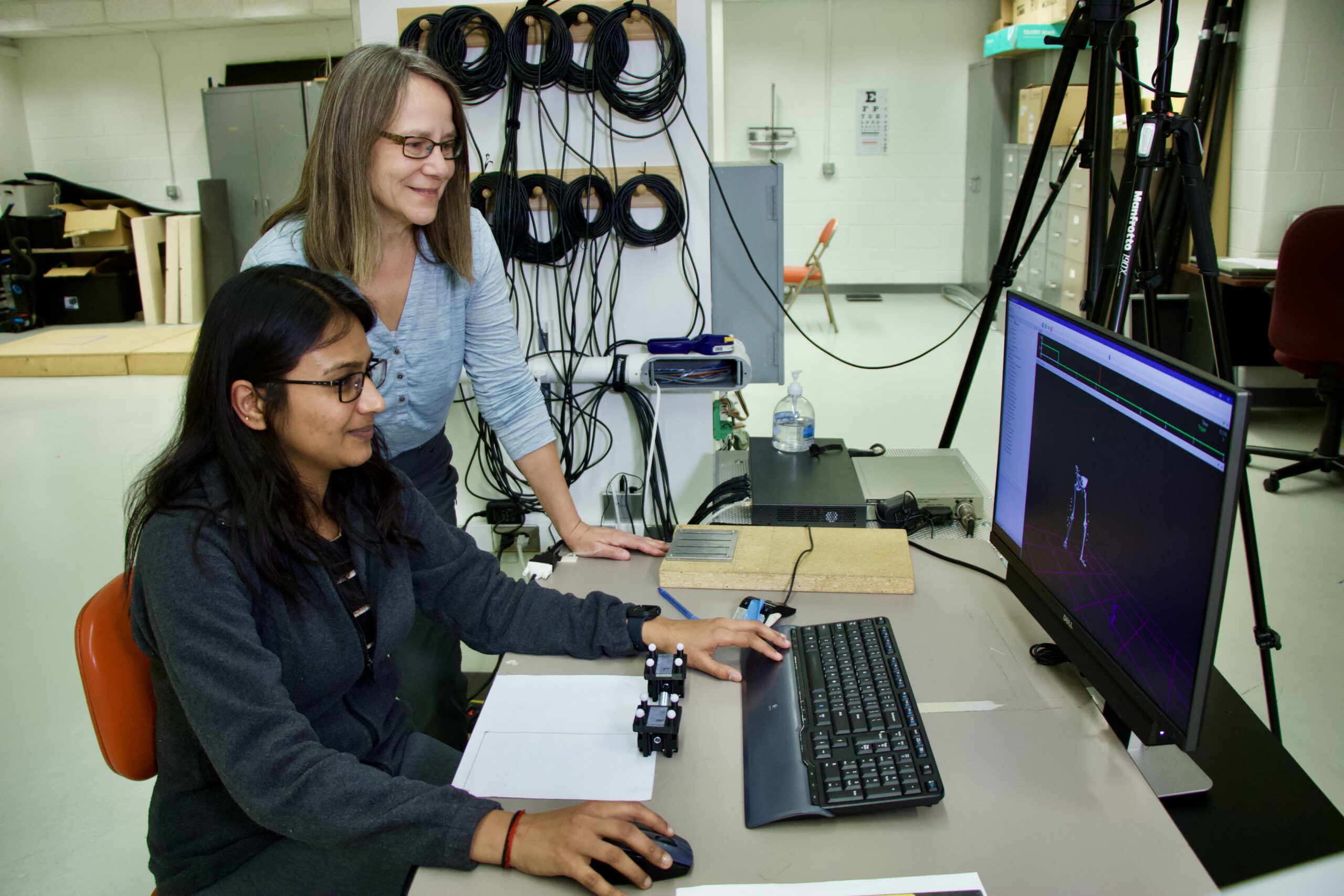Purdue HHS researchers uncover new fall factors for older Americans

The movement of older adults is studied at Purdue University’s College of Health and Human Sciences.
Written by: Tim Brouk, tbrouk@purdue.edu
One fall by an older adult can have a ripple effect that debilitates the patient and their family. There is the initial pain and injury, but the ongoing physical and mental health issues, treatment, and steps to protect that adult from falling again can be expensive and time-consuming.
To prevent and understand that first fall, Purdue University College of Health and Human Sciences researchers examined publicly available health records of almost 2,000 Americans ages 60-85. They uncovered new details that add to the demographics of those older adults most likely to fall.
“Falls can be catastrophic for older adults,” said Shirley Rietdyk, professor in the Department of Health and Kinesiology. “There’s a wide range of factors that are associated with falls, such as being female, older age, poor health, impaired cognitive ability, obesity, and others. We know that the presence of one fall-related factor doesn’t automatically mean that person will fall. But we don’t know how multiple factors interact — for example, if a male is obese, are they more protected from falls than an obese female? That’s why we did this study.”
Culled from a data set from the Centers for Disease Control and Prevention’s (CDC) National Center for Health Statistics, Rietdyk and her health and kinesiology colleagues Satyajit Ambike, Steve Amireault and Jeffrey M. Haddad; School of Nursing Associate Professor Libby Richards; and Purdue Data Science Consulting Service experts David Newton and Guang Lin found some unexpected results after cluster analyses of the patient data set.
While the work solidified some ideas from the HHS fall experts, the data revealed most people (59%) age 65-80 years had four or more factors at the same time, and each additional factor increased the odds of having difficulty with falling. Thus, when many people have four or more factors, it becomes readily apparent why falling is a serious issue in the aging population. The new insights further illustrate the factors in accidental falls, which are still the leading cause of death in people ages 65 and older, according to the CDC.
This self-funded research was published in November by PLOS ONE, a fully peer-reviewed journal.
More physical activity, fewer falls
A robust finding in the current research and previous research is the observation that physical activity is protective against falls. Physical activity may also be protective of pain associated with arthritis.
“Research demonstrating the role of pain in falls is relatively new, and most fall studies do not consider participants’ pain,” Rietdyk said. “A common source of pain in older adults is arthritis.”
Richards concurred, adding that physical activity is the best medicine in dealing with this new fall factor.
“If you can increase or maintain your physical activity, you can reduce arthritic symptoms such as pain,” she said. “For certain subgroups, weight loss, which could involve more movement, might be more beneficial for fall risk than say balance training or something like that, which we haven’t seen before.”
Ambike, an expert in balance and coordination, mapped out a scenario: “You have arthritis in your right knee, and it hurts. You are going to walk differently in an effort to minimize the pain. Over a long period of time, you will use your right leg less, and it grows weaker because you are not using it. Then, if you trip with your left leg, you will need your right leg to prevent a fall, but it’s not strong enough to stop you from falling if you have a large disturbance to your balance.”
The team found obese women are more likely to fall than obese men in the 60-85 age range. Why that occurs produced some theories.
“Women who are obese are having more challenges than men who are obese,” Rietdyk said. “Do obese women have greater challenges due to a smaller muscle mass? Is it a longer reaction time? Or perhaps it’s related to how women pay attention to the environment, which is known to be different from men. These factors may all impair the ability to detect and respond to fall hazards during women’s daily activities.
More keys to a fall

Professor of health and kinesiology Shirley Rietdyk, standing, and PhD student Ashwani Kulkarni review some human movement research.Tim Brouk
Rietdyk and her team included numerous aspects of the data set, such as gait speed and amount of physical activity per week. Most had four or more traits that would deem them at a higher fall risk — old age, impaired vision and high body mass index, for example. The number of medications were considered as well.
The team used cluster analysis to learn more about how the factors were related to falls. Cluster analysis is “unsupervised,” which means the researchers do not provide any information to the algorithm. Rather, the algorithm identifies associations and patterns to determine if there are groups of participants with similar fall-related factors. The clustering algorithm determined the participants could be categorized into three clusters: “healthiest” or lowest risk, “cognitive and sensory impaired” or moderate risk, and “health impaired” or highest risk.
“What we wanted to see was how many of these factors people have,” said Rietdyk, noting that it’s been decades since the number of factors was quantified. “The factors we included are all internal issues or what we call personal factors.”
Fear factor
Another potentially devastating aftereffect from a fall is when a patient gets the fear of falling again. Rietdyk and her team acknowledged some patients who isolate themselves and move less after a fall.
“Even if they don’t get injured, they become frightened of falling,” Rietdyk explained. “Then, they’re less likely to participate in activities, and that could lead to a whole cascade of things, such as decreased cognitive ability, decreased physical fitness.”
While challenging mentally, keeping moving is still the best policy in preventing another fall.
Family and clinicians’ roles
Richards said the research could affect bedside advice nurses give to patients who are at risk of falling or recovering from a fall. Since nurses have the most contact with such patients, promoting physical activity as a key protector against falls would be beneficial. The new findings could influence how healthy-balance programs such as Stepping On and the National Council on Aging’s Fit & Strong structure their curricula.
Younger generations are encouraged to help their older relatives take care of their health through exercise, which is known as intergenerational physical activity. Yes, railings installed in the shower are good, but walking as a family after a holiday gathering is just as beneficial. A stroll around the neighborhood is indeed preferred over the catastrophic aftereffects of a fall by an older adult.
“For an older adult living independently, that fall could result in injuries but also loss of independent living, loss of functional capacity,” Richards summarized. “We’re all aging, but we want to do it with healthy longevity. We want to have that quality of life along with that quantity of life. We know as we age our fall risk exponentially increases. So, identifying these factors that we can address and pay attention to are really important in that health longevity aspect.”
Discover more from News | College of Health and Human Sciences
Subscribe to get the latest posts sent to your email.